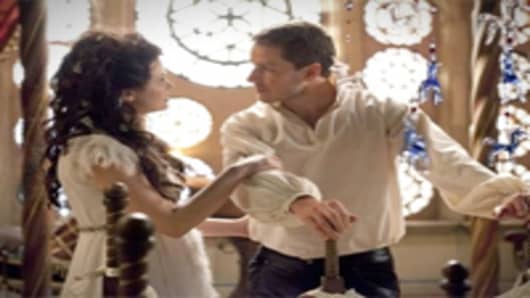Splashy premieres, extravagant budgets, yearlong advertising campaigns and mind-blowing special effects: the summer movie season may be over but Hollywood’s all-or-nothing mentality has shifted to the small screen.
This fall the television networks are trying to lure viewers with high-concept, big-budget shows like “Terra Nova,” which has computer-generated dinosaurs trying to kill off human characters, and “The X Factor,” Simon Cowell’s manic sequel to “American Idol” — all of which are on Fox.
To do that, they are spending years on development and marketing, and in some cases releasing trailers for new shows almost a year before they actually appear on TV. “Terra Nova,” which had its premiere Monday night, took two years to develop, a timeline more typical for the film industry than for television. “The X Factor” was first promoted last Thanksgiving and was finally introduced last week.
It’s true at other networks too. NBC’s “Smash,” a drama set backstage at a Broadway musical, was first previewed in May, and it will not have its premiere until February.
Clearly, the hunt is on for blockbuster shows, the kind that will, as Kevin Reilly, the president of entertainment for Fox Broadcasting, put it, “get the hooks in deep enough.” That’s why Fox promoted a $5 million prize for “The X Factor” and budgeted $15 million to $20 million for the two-hour pilot episode of "Terra Nova.”
The potential rewards are huge. According to industry estimates, “The X Factor” is charging up to $400,000 per 30-second commercial, an exceptionally high rate. “Idol,” which is nine years old and is the most popular entertainment show on American television, gets about $475,000.
But the risks are also substantial. That point was underscored when “The X Factor” attracted about 12.5 million viewers in its debut — strong by almost any standards, but below the sky-high expectations for the singing competition.
Mr. Reilly said the network’s willingness to swing for the fences this fall was in part an effort to avoid “the malaise of stuff that comes out in a clump” at the start of each new television season. If history is any guide, 70 percent of the shows that pop up this month and next (the new season officially started Sept. 19) will not survive long enough for a second season. “The viewer just sort of shrugs” each fall, Mr. Reilly said, “and that’s disappointing — and expensive.”
The alternative might be more expensive — Mr. Cowell commands an eight-figure salary and the dinosaurs on “Terra Nova” don’t come cheap either — but it may improve TV’s batting average. Marquee shows tend to be nurtured more carefully and promoted more aggressively, improving the odds that viewers will tune in at least once. The shows can be sold more easily overseas and to digital platforms like Netflix, making it easier to recoup the costs of production and turn a profit.
Steve Sternberg, an independent television analyst, said that CBS and NBC were “playing it relatively safe” this season, but that ABC was taking risks with the retro drama “Pan Am,” the fairy tale-inspired “Once Upon a Time,” and the soapy Hamptons-set “Revenge,” “none of which are currently like anything else on broadcast TV.”
When Paul Lee, the president of entertainment for ABC, took over the network’s ailing prime-time schedule last year, he signaled that he wanted to empower the producers of individual shows to experiment.
“Big failures come from that, and you have to be ready to fall on your face,” he told reporters last winter. “But brand-defining television comes from that. I encourage that; we don’t want cookie-cutter television.”
Risk-taking paid off for ABC in 2004 when it introduced “Lost,” the sprawling science-fiction show. But since then, it has spent heavily on shows like the time-bending mystery “Flash Forward” that have not attracted viewers.
A risk-taking attitude was evident in the halls of the Fox network on a recent visit, where marketers were furiously finishing Web ads for “The X Factor,” teasers for “Terra Nova” and billboards for a new sitcom called “New Girl,” which had high ratings in its premiere last Tuesday night.


